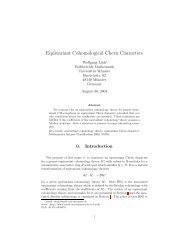Connes-Chern Character for Manifolds with Boundary and ETA ...
Connes-Chern Character for Manifolds with Boundary and ETA ...
Connes-Chern Character for Manifolds with Boundary and ETA ...
Create successful ePaper yourself
Turn your PDF publications into a flip-book with our unique Google optimized e-Paper software.
80 MATTHIAS LESCH, HENRI MOSCOVICI, AND MARKUS J. PFLAUM<br />
such that <strong>for</strong> all σ ∈ ∆ k , σ j > 0<br />
‖A 0 e −σ 0tD 2 (I − H)A 1 · . . . · A k e −σ ktD 2 (I − H)‖ 1<br />
( k∏<br />
)<br />
≤ C(δ, ε) σ −a j/2<br />
j t −a/2−(dim M)/2−ε e −tδ , <strong>for</strong> all 0 < t < ∞.<br />
j=0<br />
(B.21)<br />
In particular, a j ≤ 1, j = 0, ..., k, then<br />
‖(A 0 (I − H), ..., A k (I − H)) √ tD ‖<br />
= O(t −a/2−(dim M)/2−0 e −tδ ), <strong>for</strong> all 0 < t < ∞.<br />
(B.22)<br />
Proof. We first reduce the problem to the case that all A j are compactly supported. To<br />
this end choose ϕ j0 −1, ϕ j0 ∈ C ∞ 0 (M) such that supp ϕ j0 ∩ supp(1 − ϕ j0 −1) = ∅ <strong>and</strong> such<br />
that ϕ j0 A j0 = A j0 ϕ j0 = A j0 . Decompose A j0 −1 = A j0 −1ϕ j0 −1 + A j0 −1(1 − ϕ j0 −1).<br />
First we show that the estimates (B.19), (B.21) hold if we replace A j0 −1 by A j0 −1(1−<br />
ϕ j0 −1):<br />
Case 1. Proposition B.5.3 gives<br />
‖A j0 −1(1 − ϕ j0 −1)e −σ j 0 −1tD 2 ϕ j0 ‖ 1 ≤ C t0 σ N j 0 −1t N , <strong>for</strong> σ j0 −1t ≤ t 0 . (B.23)<br />
The operator norm of the other factors can be estimated using the Spectral Theorem,<br />
taking into account the D a j<br />
–boundedness of A j :<br />
Hence by the Hölder inequality<br />
‖A j e −σ jtD 2 ‖ ≤ C t0 (σ j t) −a j/2 , <strong>for</strong> σ j t ≤ t 0 . (B.24)<br />
‖A 0 e −σ 0tD 2 A 1 · . . . · A j0 −1(1 − ϕ j0 −1)e −σ j 0 −1tD 2 · A k e −σ ktD 2 ‖ 1<br />
( k∏<br />
≤ C t0 σ −a j/2<br />
j<br />
)t − P k a j +N<br />
j=0 , 0 < t ≤ t0 ,<br />
j=0<br />
(B.25)<br />
which is even better than (B.19).<br />
Case 2 (D Fredholm). From (B.23), Proposition B.6 <strong>and</strong> the fact that H is a finite<br />
rank operator <strong>with</strong> e −ξD2 H = H we infer<br />
‖A j0 −1(1 − ϕ j0 −1)e −σ j 0 −1tD 2 (I − H)ϕ j0 ‖ 1<br />
≤ C δ e −σ j 0 −1tδ , <strong>for</strong> all 0 < t < ∞.<br />
(B.26)<br />
To the other factors we apply Proposition B.6 <strong>with</strong> p = ∞:<br />
‖A j e −σ jtD 2 (I − H)‖ ≤ C δ (σ j t) −a j/2 e −σ jtδ , 0 < t < ∞. (B.27)<br />
The Hölder inequality combined <strong>with</strong> (B.26),(B.27) gives (B.21).<br />
Altogether we are left to consider A 0 , ..., A j0 −1ϕ j0 −1, A j0 , ...A k where now A j0 −1ϕ j0 −1<br />
<strong>and</strong> A j0 are compactly supported. Continuing this way, also to the right of j 0 , it remains<br />
to treat the case where each A j has compact support.

















